Acer T232HL - Touch Comes to the Desktop
by Chris Heinonen on February 6, 2013 9:00 AM ESTColor Quality and Gamut
Straight out of the box, the best numbers that the Acer can produce on our Gretag Macbeth test are pretty poor. The average dE is over 8, and the grayscale numbers are the worst that I’ve measured. The only shade even close to being an ideal number is yellow, with everything else having an error of 5 or above.
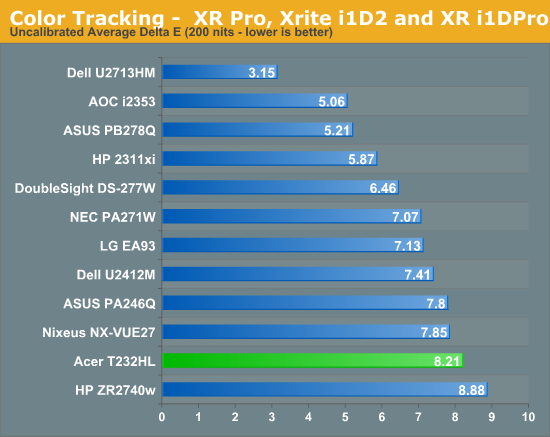
For our calibration tests we use ColorEyes Display Pro, an i1Pro meter, and we target 200 nits of light output, a gamma of 2.2, a white point of D65, and the minimum black level we can hit. Any adjustments that we can make in the monitor to correct white balance or colors are done before the calibration, and the best starting mode is used. I always try calibrations with and without DDC enabled in ColorEyes Display Pro, but haven’t run into a result in a long time where hand tuning it was better than using DDC; they are usually identical.
After calibration, the Acer is really improved. The grayscale has gone from abysmal to very accurate, and the remaining flaws are in shades of blue that almost always cause monitors trouble. If you care about color quality, you really do need to calibrate the Acer as without a calibration, the colors are just far from ideal.
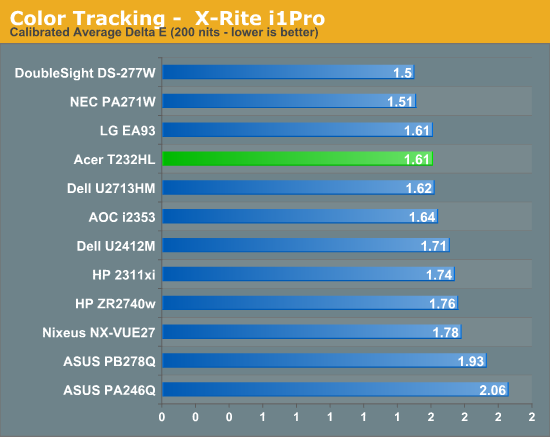
After that calibration we target 100 nits, which is more likely to be used with print or paper work than with on screen design work. We don’t get quite as good of results here, and the grayscale error is a good bit higher than before as well. It isn’t poor, but it’s not as good as other monitors can do, but this display also isn’t targeted towards print professionals.
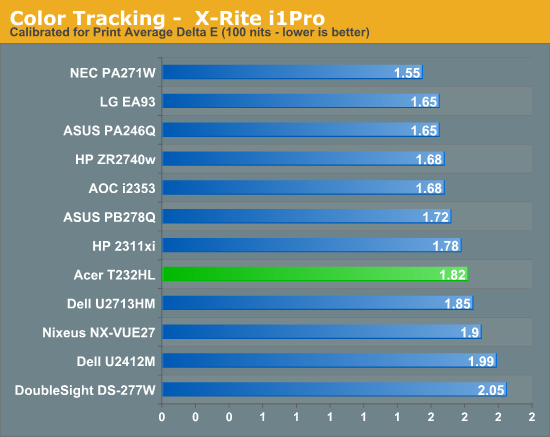
So we have really poor initial color, very nice post-calibration color, and so-so calibration color for print work. If you really care about color quality then you’re going to want to calibrate it, and even if you don’t the level of error is high enough that it might be a bit distracting, especially since the grayscale is so bad.
The gamut is supposed to be sRGB and here it comes up just a little bit short. We look for 71% of AdobeRGB to be equal to sRGB, but we only get 68% of the AdobeRGB gamut here. This also comes in near the bottom of the monitors recently reviewed, and isn’t too unexpected due to the LED lighting which often falls short.
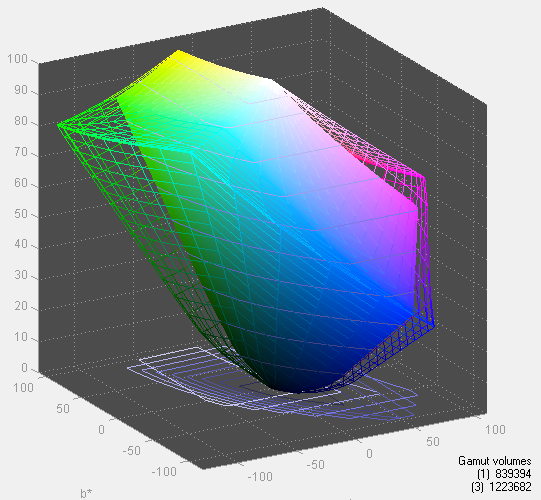



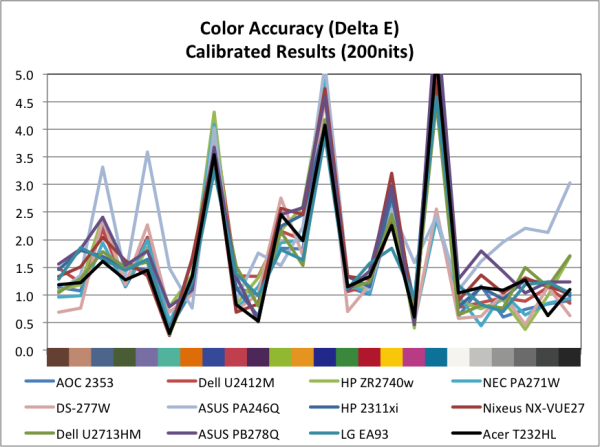









66 Comments
View All Comments
EJ257 - Wednesday, February 6, 2013 - link
Or just put a label on the bezel that say "Screen coated with contact poison"DanNeely - Wednesday, February 6, 2013 - link
*laugh*expect people to read*laugh*not to mention expecting them to believe it*laugh*After a few shocks most will get the hint.
cjs150 - Wednesday, February 6, 2013 - link
Take away the touch screen and what you have is a poor monitor. Out of the box it is just not good enough, with correct calibration it becomes adequate and because of the touch gimmick overpricedThen there is the touch gimmick. On my work computer, which only has a 17" screen, I have placed at a comfortable distance to read, which means to touch it I would have to lean forward. On a bigger screen it would be even further back.
W8 on the desktop will no doubt be a benefit for chiropractors and physiotherapists having to deal with the RPI injuries caused in the workplace caused by dealing with touch screen, for anyone else touch on a desktop is of very doubtful use.
Homeles - Wednesday, February 6, 2013 - link
There's essentially a whole half of an operating system that is designed around touch. There are plenty of applications where a touch screen is useful. It is unfortunate that you appear to be unable to come up with any besides the asinine benefit of lining the pockets of doctors.Zak - Wednesday, February 6, 2013 - link
@Homeles: I take it you actually tried using a large desktop monitor with touch GUI for real work and extended period of time and actually liked it?Kiste - Thursday, February 7, 2013 - link
Neither chiropractors nor physiotherapists are usually doctors. In fact, chiropractors are mere quacks.Other than that, why don't you name a couple of these applications where a touch screen is useful and offers a clear benefit over mouse on a desktop computer?
.
cjs150 - Thursday, February 7, 2013 - link
Homeles: if you look at tablets and smartphones there are many examples of applications that work well with touch but when you are talking about a WORK desktop you should consider what the majority of people actually do on the computer:email
word processing
data entry
excel
graphic manipulation (if you work in media)
Graphic manipulation requires precision which lends itself to a graphic tablet and the rest involve typing which means a keyboard and if you ever tried word processing using touch you will understand why a mouse and a keyboard is better
ejdrouillard - Wednesday, February 6, 2013 - link
If I'm spending over $500 on a monitor, I expect way more than 1080p.Golgatha - Wednesday, February 6, 2013 - link
For a primary display, I would absolutely not want a touch screen. I agree with the previous posters about kids. I have 2 of them and I have to clean the tablet, iTouch, and laptop screens (not to mention my desktop's mouse) on a regular basis. 24hrs and that screen would be filthy.Now if I could have a cheap secondary screen that was wireless, I might be interested as it could replace a tablet in the house. The range on such a device would need to be pretty exceptional though.
HardwareDufus - Wednesday, February 6, 2013 - link
Actually I plan on buying this monitor to preemptively solve crimes like Tom Cruise in Minority Report.